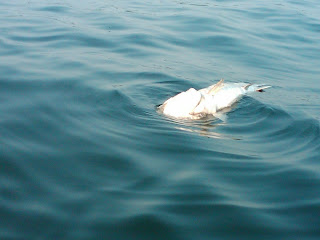 |
| Step 1: Secure bead head to the front of the hook. |
 |
| Step 2: Wrap thread to the back of the fly and tie in a 3" piece of copper wire. |
 |
| Step 3: Tie in 2 black goose biots so they form a "V" off of the back of the fly. |
 |
| Step 4: Tie in a piece of black swiss straw just in front of the goose biots and wire. |
 |
| Step 5: Wrap the tread to just in front of the mid point of the hook shank and tie in centipede legs to each side. |
 |
| Step 6: Wrap the thread back to the rear of the fly and spin dubbing around the thread. |
 |
| Step 7: Wrap the thread with the dubbing on it all the way up to the front of the fly. Make sure the middle of the fly (in between the legs) is the fattest part of the fly. |
 |
| Step 8: Wrap the copper wire around the body of the fly making sure to leave space in between raps so the black dubbing will show through. Tie off the copper wire wen it reaches the front of the fly and clip any extra wire. |
 |
| Step 9: Pull the swiss straw from the rear of the fly to the front and tie down just behind the bead head. The swish straw will create a back to the fly. |
 |
| Step 10: Tie 2 black goose biots in behind the beadhead. they should form a "V" wen tied in. Once secured, clip the tag ends. |
 |
| Step 11: Spin a small amount of dubbing around the thread and wrap dubbing from the base of the goose biots to the bead head to hide the thread wrapping that shows from tying in the goose biots and swish straw. After the dubbing is wrapped around the fly, whip finish and apply head cement. |
Hook: Daiichi size 10 style 1550 wet/nymph hooks
Thread: Black ultra thread
Materials: 4 black goose biots, 3" piece of medium copper wire, black centipede legs, tungsten bead head, swish straw, head cement, and black dubbing.
Tools: bobbin, scissors, and whip finish tool
This stone fly pattern works well for many species of fish. Where ever there are stoneflies this pattern works well. I use this pattern in size 10 and 12 for steelhead during the fall, winter, and spring. It can be tied in any size and any color combination. It can be tied without a bead head, but I like the bead head because it will get the fly down to the bottom where it needs to be faster and doesn't require the use of split shot. Stonefly patterns are a must for everyones fly box and this is my favorite and most effective stonefly pattern in my box.




















































